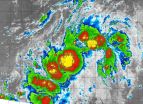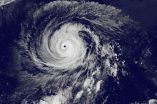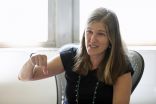INFORMATION:
The more the merrier for animals that synchronize their behavior
Findings may increase understanding of effects of people living in groups or alone
2015-09-01
(Press-News.org) BUFFALO, N.Y. - Social interaction could be the mechanism that allows animals living in groups to synchronize their activities, whether it's huddling for warmth or offering protection from predators.
This social presence affects the daily rhythm of activity and rest, and the larger the group, the greater the likelihood of synchronization, according to a study published recently in the journal Biology Letters.
"At least in mice, and perhaps in other animals, this study shows quite dramatic synchrony amongst groups of animals that can only be explained by social interactions," said University at Buffalo psychologist Matthew Paul, lead author of the study with Premananda Indic and William Schwartz of the University of Massachusetts Medical School.
All animals have daily rhythms, sometimes called circadian rhythms, a term derived from Latin, meaning "around a day." At one time these rhythms were thought to be generated by a direct response to the daily cycle of lightness and darkness. But even without light or other external cues, most animals still have a 24-hour rhythm.
In the absence of external cues, something internal must be regulating these rhythms, according to Paul.
Most studies examining how animals time their behaviors have used only animals living alone, and it has been assumed that species members synchronized to a common external cue.
However, social regulation of circadian clocks is another possibility. The trend was present in previous experiments, but the results were mixed.
"We took the view that it was necessary to find out what the rules might be that govern social influences on these clocks," said Paul. "If these social interactions do influence our clocks, then knowing the rules would help us understand how that works."
Paul says one possible rule is that social synchronization requires larger numbers of animals, and the likelihood of synchronization increases as the size of the group increases.
"The answers to the question of whether social interactions can affect our biological clocks - can cause synchrony - have been spotty in the past perhaps in part because the experiments didn't use enough animals living together."
The researchers determined synchrony by measuring the body temperature rhythms of the mice. The study didn't go into detail to determine if, for example, all the mice were eating at the same time, but Paul says the overall implication is that their general activities are synchronized.
"This experiment suggests that living in groups can affect our rhythms, but we still need to know more." said Paul "In order to remove external cues we did this experiment in constant darkness, an environment that mice prefer."
"The next question is what happens in the light-dark cycle? That cycle synchronizes us in general, but now we have another force that's affecting our clock and we can learn how these two forces act together. Once we find that out we will know more about the effects of animals, and perhaps even humans, living in groups and those living alone."
ELSE PRESS RELEASES FROM THIS DATE:
Economic security requires new measures of well-being
2015-09-01
BUFFALO, N.Y. - Economic well-being for low-income families in the U.S. is often determined by federal measures that establish basic requirements for essentials such as food, shelter and clothing, but a new study by a University at Buffalo research team suggests that such a definition is unrealistically narrow.
To help families move out of poverty, the existing perspective of economic well-being and its short-term focus on basic needs should reflect possibilities for long-term stability, including a savings plan, rather than day-to-day survival, says Yunju Nam, an associate ...
Story tips from the Department of Energy's Oak Ridge National Laboratory, September 2015
2015-09-01
To arrange for an interview with a researcher, please contact the Communications staff member identified at the end of each tip. For more information on ORNL and its research and development activities, please refer to one of our media contacts. If you have a general media-related question or comment, you can send it to news@ornl.gov.
MATERIALS - Solar bake test for NASA ...
To test an instrument for a spacecraft that will fly closer to the sun than any before, engineers at Oak Ridge National Laboratory and the University of California-Berkeley used ORNL's powerful ...
To email or not to email? For those in love, it's better than leaving a voice message
2015-09-01
BLOOMINGTON, Ind. -- In her hit single, Carly Rae Jepsen may have sung, "Here's my number, so call me maybe." But according to a new research study from Indiana University, she might be more successful in finding love if she asked him to send her an email.
The research, which has been accepted for publication in the journal Computers in Human Behavior, suggests that, in this digital age, an email can be more effective in expressing romantic feelings than leaving a voicemail message.
Previous research and conventional wisdom suggested the opposite, that a voicemail message ...
How much liposuction is 'safe'? The answer varies by body weight
2015-09-01
September 1, 2015 - What's the "safe" amount of fat to remove in patients undergoing liposuction? Rather than a hard-and-fast rule, the answer depends on the patient's body mass index (BMI), according to a report in the September issue of Plastic and Reconstructive Surgery®, the official medical journal of the American Society of Plastic Surgeons (ASPS).
"Our study shows that liposuction is associated with a very low complication rate, with major complications occurring in less than 1 in 1,000 patients," comments ASPS Member Surgeon John Y.S. Kim of Northwestern ...
Yeast study yields insights into cell-division cycle
2015-09-01
ANN ARBOR--Studies using yeast genetics have provided new, fundamental insights into the cell-division cycle, researchers at the University of Michigan Life Sciences Institute report.
Findings published Aug. 31 in the journal eLife show that an organelle known as the vacuole, which performs a variety of cellular housekeeping functions, plays an essential role in the initiation of the cell-division cycle.
The cell-division cycle, also known simply as the cell cycle, is the series of events inside a cell that leads to its division.
"The yeast vacuole has a counterpart ...
Study in mice suggests how anesthesia may fight lung infections
2015-09-01
In use for more than a century, inhaled anesthetics like nitrous oxide and halothane have made modern surgery possible. Now, in experiments in mice, researchers at Johns Hopkins and elsewhere have added to evidence that certain so-called "volatile" anesthetics -- commonly used during surgeries -- may also possess powerful effects on the immune system that can combat viral and bacterial infections in the lung, including influenza and pneumonia.
A report on the experiments is published in the September 1 issue of the journal Anesthesiology.
The Johns Hopkins and University ...
NASA-NOAA's Suomi NPP satellite sees Tropical Depression 14E disorganized
2015-09-01
Tropical Depression 14E was born in the Eastern Pacific Ocean early on September 1 when NASA-NOAA's Suomi NPP satellite passed overhead and looked at it in infrared light.
Infrared light shows temperature, which is helpful in determining cloud top temperatures of the thunderstorms that make up a tropical cyclone line Tropical Depression 14E (TD 14E). The colder the storm, the higher they stretch into the troposphere (lowest layer of the atmosphere) and the stronger the storms tend to be.
On September 1 at 0900 UTC (5 a.m. EDT), NASA-NOAA's Suomi NPP satellite passed ...
NASA sees wind shear affecting Hurricane Ignacio
2015-09-01
Hurricane Ignacio is staying far enough away from the Hawaiian Islands to not bring heavy rainfall or gusty winds, but is still causing rough surf. Infrared satellite data on September 1 shows that wind shear is adversely affecting the storm and weakening it.
The Atmospheric Infrared Sounder or AIRS instrument that flies aboard NASA's Aqua satellite gathers infrared data that reveals temperatures. When NASA's Aqua satellite passed over Ignacio on September 1 at 11:41 UTC (7:41 a.m. EDT), the AIRS data and showed some high, cold, strong thunderstorms surrounded the center ...
Could tiny jellyfish propulsion drive design of new underwater craft?
2015-09-01
EUGENE, Ore. - Sept. 1, 2015 - The University of Oregon's Kelly Sutherland has seen the future of under-sea exploration by studying the swimming prowess of tiny jellyfish gathered from Puget Sound off Washington's San Juan Island.
In a paper with four colleagues in the Sept. 2 issue of the journal Nature Communications, Sutherland details how a tiny type of jellyfish - colonial siphonophores - swim rapidly by coordinating multiple water-shooting jets from separate but genetically identical units that make up the animal.
Information on the biomechanics of a living organism ...
Marine animal colony is a multi-jet swimming machine, scientists report
2015-09-01
WOODS HOLE, MASS.--Marine animals that swim by jet propulsion, such as squid and jellyfish, are not uncommon. But it's rare to find a colony of animals that coordinates multiple jets for whole-group locomotion. This week in Nature Communications, scientists report on a colonial jellyfish-like species, Nanomia bijuga, that uses a sophisticated, multi-jet propulsion system based on an elegant division of labor among young and old members of the colony. This locomotive solution, the team suggests, could illuminate the design of underwater distributed-propulsion vehicles.
"This ...
LAST 30 PRESS RELEASES:
Longest observation of an active solar region
Why nail-biting, procrastination and other self-sabotaging behaviors are rooted in survival instincts
Regional variations in mechanical properties of porcine leptomeninges
Artificial empathy in therapy and healthcare: advancements in interpersonal interaction technologies
Why some brains switch gears more efficiently than others
UVA’s Jundong Li wins ICDM’S 2025 Tao Li Award for data mining, machine learning
UVA’s low-power, high-performance computer power player Mircea Stan earns National Academy of Inventors fellowship
Not playing by the rules: USU researcher explores filamentous algae dynamics in rivers
Do our body clocks influence our risk of dementia?
Anthropologists offer new evidence of bipedalism in long-debated fossil discovery
Safer receipt paper from wood
Dosage-sensitive genes suggest no whole-genome duplications in ancestral angiosperm
First ancient human herpesvirus genomes document their deep history with humans
Why Some Bacteria Survive Antibiotics and How to Stop Them - New study reveals that bacteria can survive antibiotic treatment through two fundamentally different “shutdown modes”
UCLA study links scar healing to dangerous placenta condition
CHANGE-seq-BE finds off-target changes in the genome from base editors
The Journal of Nuclear Medicine Ahead-of-Print Tip Sheet: January 2, 2026
Delayed or absent first dose of measles, mumps, and rubella vaccination
Trends in US preterm birth rates by household income and race and ethnicity
Study identifies potential biomarker linked to progression and brain inflammation in multiple sclerosis
Many mothers in Norway do not show up for postnatal check-ups
Researchers want to find out why quick clay is so unstable
Superradiant spins show teamwork at the quantum scale
Cleveland Clinic Research links tumor bacteria to immunotherapy resistance in head and neck cancer
First Editorial of 2026: Resisting AI slop
Joint ground- and space-based observations reveal Saturn-mass rogue planet
Inheritable genetic variant offers protection against blood cancer risk and progression
Pigs settled Pacific islands alongside early human voyagers
A Coral reef’s daily pulse reshapes microbes in surrounding waters
EAST Tokamak experiments exceed plasma density limit, offering new approach to fusion ignition
[Press-News.org] The more the merrier for animals that synchronize their behaviorFindings may increase understanding of effects of people living in groups or alone



